
It is almost midsummer at least astronomically. On Wednesday of this week the season is in full swing with the passing of the summer solstice whereby the northern hemisphere is closest to the sun and we experience the longest day. That’s right, tomorrow is the summer solstice! Never mind that we are going to be experiencing 92+ degree heat. Wow, where has the time gone? The normal tradition of a solstice bonfire may not be the best idea this year even if you believe the hype and it may be the last summer solstice ever!

My blog posts, as usual, have been few and far between as the weather has continually improved and I spend more time outdoors either in my garden, in the field doing ecological evaluation and survey work or in other people’s yards assisting them with their projects. This spring I spent some time working on the walkway garden that Billy, my project collaborator from Cascade Designs Inc., and I installed last fall. Although bloom timing has been skewed by the very mild winter and abnormally warm early spring things are starting to fill in nicely.
Prior to the new walkway the entrance to our recently purchased home consisted of an “L-shaped” broken brick walkway with no aesthetic appeal and very little function. My goal was to provide a welcoming entrance with sensory appeal for myself and my guests, both visual and olfactory (oh, and to eliminate some of the ecologically functionless lawn that came with the front yard, much to my lawn-loving husband’s chagrin).
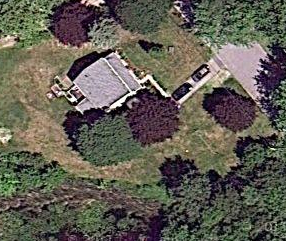
This was my first foray into this kind of design as my previous gardens have been more for the “birds and bees” and for this reason they sometimes lacked defining detail for the “human” eye. Being an ecologist and not a landscape architect I attempted to take into consideration common design principles including shape, flow, function, line, texture and color while still keeping the ecological function of the project a major component. This actually meant that I allowed myself to stray from my native plant philosophy to some extent and I also allowed myself to use cultivars (go figure…). However, in many cases I used plant material I “sourced” from my other growing areas so many of the preferable natives appear again and again within the overall palette.
I used boulders including a standing stone or lithe to help define the overall shape and provide interest.

Also, during installation of the walkway and the bench circle I was looking for something different. Billy came up with the idea of using a boulder to encroach into the stone walkway as an interest feature. He meticulously cut the circle stones to fit around the boulder. Loved it!

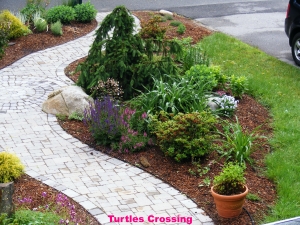
From the sensory standpoint the walkway is surrounded by a heady mix of sensual smelling plants including lavender, thyme, marjoram, sage, evening primrose, roses and lilac. For the birds and bees I made extensive use of some of my favorites including Penstemon digitalis ‘husker red'(Beardstongue)

Liatris spicata (Blazing Star); Aruncus aethusifolius (Goat’s Beard); Echinacea purpurea (Purple Coneflower); Rudbecki hirta (Black Eyed Susan) and its cultivars ‘indian summer’ and ‘angustifolia’;
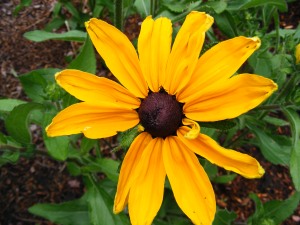
Agastache (Hummingbird mint); Monarda didyma ‘Jacobs Cline’ (Red bee balm); Eupatorium purpureum (Purple Joe-Pye); Chrysanthemum leucanthemum (Ox Eye Daisy); Achillea millefolium and Achillea lanulosa (Yarrow);
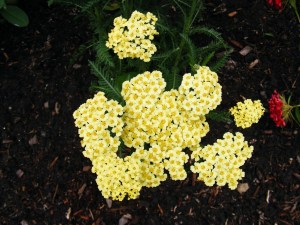
Asclepias tuberosa (butterfly weed); Aslepias syriaca (Common milkweed); Aster Novae Angliae (New England Aster); Aster Novi Belgii (New York Aster); Salvia nemerosa (Sage)

including the varieties ‘may night,’ ‘indigo spires;’ and multiple varieties of Salvia offinalis including ‘tricolor.’ The larger wood specimens were picked for their form and shape including the weeping cherry, weeping Norway spruce and holly.

These shrubs repeat the triangular design of the boulders embedded within the garden.

On a warm evening it is wonderful to sit in the rocker on the front porch and enjoy the scent. Also, the front yard wildlife do not seem to have any complaints either,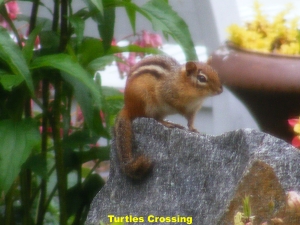
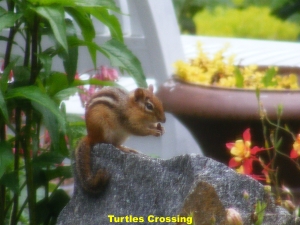

But, being a gardener I am already planning on what needs to be moved and to where, and of course I am already onto my next project which is the expansion of my back butterfly garden along with design and integration of a new sitting patio into it. Gotta love the gardening bug!


Okay, you are hired!